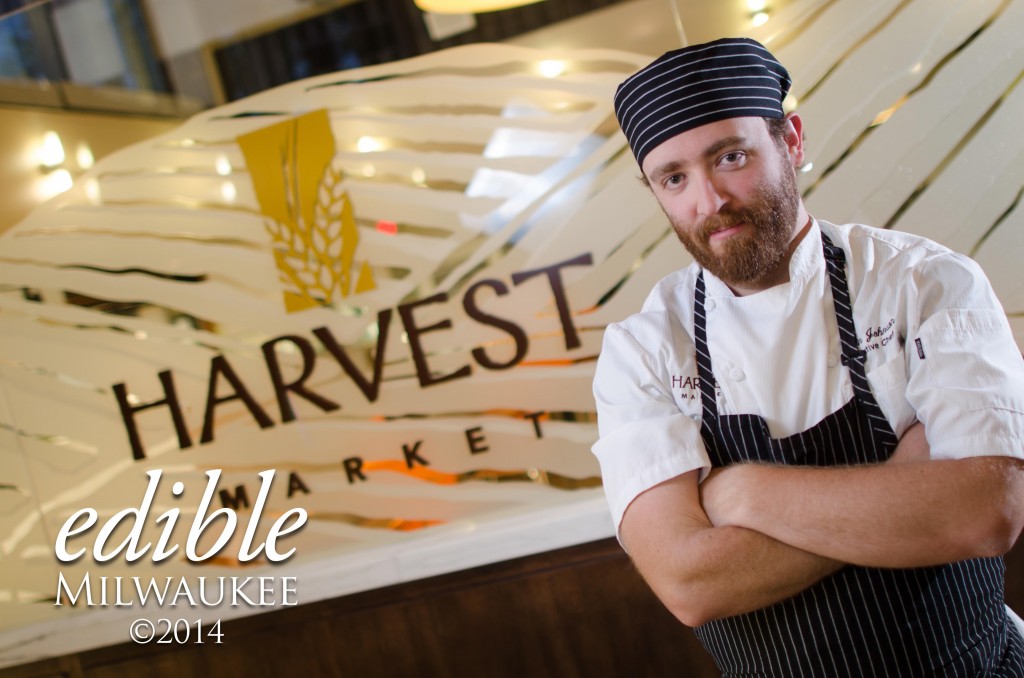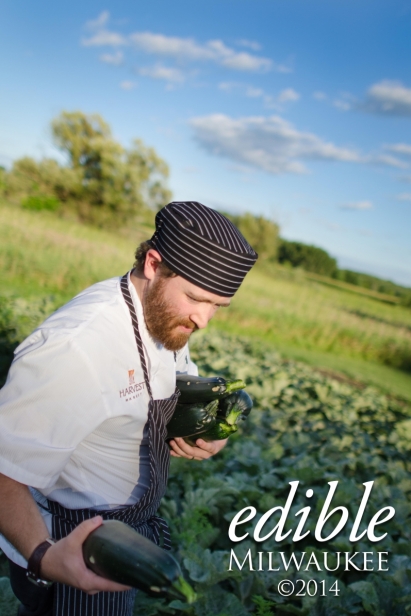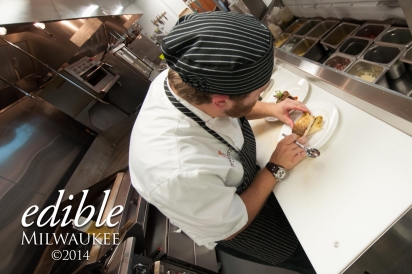Food as Medicine
Watertown’s Harvest Market transforms “hospital food” into scratch-made, farm-to-table fare
Picture a delivery truck parked at the loading dock of a hospital, the smell of diesel exhaust punctuated by the thump of boxes, cases and cans being loaded onto a dolly. This is food, and it will be fed to patients, visitors and staff in short order.
Now picture an entirely different scene: gone are most of the delivery trucks. Gone are the canned vegetables and sauces, frozen and pre-portioned proteins, vacuum-sealed this and boxed-mix that. Gone are the freezers that held most of the food, the warming ovens that heated it, some of the people who prepared it, and even the walls around it.
Such was the recent transformation of the food service operations at the Watertown Regional Medical Center (WRMC), in a modest town of 24,000 an hour west of Milwaukee.
In place of everything that has been subtracted from this tucked-away hospital stands Harvest Market, an honest-to-goodness restaurant with a gleaming new custom-designed kitchen, dining room and lounge, specialized storage and preparation facilities, state-of-the-art equipment, an 11,000-square-foot garden out back, a kitchen classroom in front, and a dedicated staff of trained chefs, cooks and dietitians who create scratch dishes from fresh ingredients. All based on a philosophy of food as medicine.
Leading this metamorphosis from institutional food service to wholesome, flavorful restaurant cooking was a team of administrators focused on the health of the surrounding community, where rates for obesity and death from heart disease are higher than both state and national averages. This new approach took root in 2011 when WRMC president and CEO John Kosanovich and other administrators toured Growing Power, a Milwaukee-based urban farm and agricultural organization that helps provide equal access to healthy, high-quality, safe and affordable food.
“The investment in Harvest Market is really an investment in our community,” said Tina Crave, WRMC’s VP and chief experience officer. “It’s our goal to help folks learn how to eat and cook healthy food in an enjoyable way, and challenge them to move away from processed convenience food.”
To lead this charge the hospital found an experienced, Le Cordon Bleu-trained chef, Justin Johnson, with a similar transition already under his belt.
From 2008-11 Johnson was executive chef at Harwood Place Retirement Community in Wauwatosa, where he turned a tired, bland, heat-and-serve operation into a restaurant-style one offering high-quality cuisine in two remodeled dining areas.
After a stint as executive chef at downtown Milwaukee’s landmark Hotel Metro, Johnson responded in early 2012 to the medical center’s ad seeking a professional chef. Intrigued, he had several interviews with top administrators during which he cooked dishes he thought could work in the new restaurant, and they discussed the radical new approach the hospital hoped to take.
After discovering their visions aligned, Johnson quickly got busy laying the gustatory groundwork while the existing cafeteria and kitchen spaces were gutted, redesigned and rebuilt to include an inpatient line in the back of the house for made-to-order room service, and open, market-style cooking spaces in front for cooks to interact with customers and create sandwiches, salads, flatbreads and skillet dishes by request before their eyes.
Food service was just one dimension of the overall makeover, said Johnson.
“The hospital wants to be best in class,” he said. “We want the best customer service ratings in the country. We want to treat healthcare more like health care, not just treating sick people. Nourishment, mental health, physical health, all of it. The food-as-medicine component focuses on nutrients and preparation, but it’s just one part of a bigger picture.”
Edible Milwaukee discussed with Johnson, Crave, and Market Chef Guide Erik Schuelke how this transition unfolded and has evolved since Harvest Market opened last year.
What are some of the most significant changes to the food from how it used to be prepared?
Johnson: It was a standard hospital cafeteria. Everything was brought in premade. Soups came frozen in bags. Entrees came in aluminum tins, full of trans fats, chemicals, salt and sugar. There were a few things made in-house. One of the most popular dishes was Chicken Wisconsin—a bed of overcooked brown rice topped with a dried-out, flavorless chicken breast and a ladle of lukewarm, straight-out-of-the-can nacho cheese sauce. I remember sitting in the dining room on my third day looking at my plate, completely shocked. Another was Beef Stroganoff, which was made by combining two five-pound blocks of frozen diced beef with six large cans of cream of mushroom soup and baking it for two hours. The next day I showed the staff how to make it from scratch: sear the meat, add tomatoes, onions and garlic, add demi-glace, temper in the sour cream so it doesn’t break. We talked about building flavors, and then tasted it. One person shook her head and said, “I just realized I don’t know anything about cooking.” That was our starting point.
How did you determine whether the staff would be able to execute a new menu and style of cooking?
Johnson: I designed a 26-week culinary training program of classroom stuff—food history, fundamentals, physiology of taste, why certain things taste good with other things—and hands-on kitchen learning: eggs, vegetables, meat, entrée architecture, soups, potatoes. For the final, we took over the Watertown Country Club for a night and did three or four seatings for about 40 people. It was the staff’s introduction to cooking to order. They did an amazing job. Four of the six who completed the program are in key cooking positions to this day.
Schuelke: Before I went through the class with Justin, I didn’t know a ton about cooking. I hadn’t worked with chefs before. We were just people who worked here. Everything was pulled from a freezer, baked and set out. Now everything is raw and we cut it and cook it with fire. We didn’t have fire before.
How does the menu align with the emphasis on wholesome food?
Crave: There’s a lot of collaboration that takes place between the chefs and our registered dietitians. Our goal is for about 80 percent of our food to be healthy, and about 20 percent traditional comfort foods prepared in a healthier manner. Our dietitians evaluate the nutritional content of every recipe and work with the chefs to modify it in order to reduce calories, lower sodium, or increase fiber. Together, they balance how to make it as healthy as possible while ensuring it’s something all our guests will enjoy eating.
How did the massive garden come about?
Johnson: Initially we thought it would be cool to have some herb pots out the back door of the kitchen. My boss at the time took me around the grounds one day and asked where we might put the herb pots. Then he asked, “what if we did a raised garden?” I said that would be amazing. Then he walked over to a community garden at a nearby senior facility and he said “what about something this size?” I said great, even better. But a week later he was thinking it might not be big enough or generate enough produce, so he walked me across the parking lot and down a hill to this huge space the size of a football field and said, “what if we did it here?” I couldn’t believe it. That was the first moment where I realized they were really serious.
How do you get what you can’t grow on site?
Johnson: In the old restaurant, all vegetables were frozen. Potatoes were freeze-dried pearls, basically just starch with a bunch of trans-fat and salt and BHT. All proteins were frozen. Now, all produce comes from our garden, or fresh from a wholesaler or local farm. We work with Sprouting Acres CSA for produce and Good Morning Babies Beef for a whole cow. We’ve worked with other farms on a one-off basis for things like strawberries, and we have a farmers market at the hospital.
What was the adjustment for the staff to working with fresh ingredients?
Johnson: The biggest reason we get in whole chickens and whole fish and a cow is so that the chefs and cooks have a relationship with the food from a raw state. If you have a case of 30 vacuum-sealed frozen salmon fillets that you rip open and line up on a sheet tray and you burn them, what do you care? You throw them away, open another box and put in 30 more. But if you have to cut the fish with your hands… and have to go through the whole laborious process of skinning, de-boning, filleting and cooking it, you’re going to be that much more invested in what you’re doing. Now if you burn it, you have to go through all that work again. You wasted all that time. Cooking from scratch engages the brain and gives us a relationship with the ingredient.
How have the staff contributed to the menu or operations?
Johnson: They’re a huge part of the identity of the food, and I’ve come to view the restaurant as a co-op in that regard. They have a tremendous amount of autonomy to create dishes. If anyone has an idea, they can roll with it. They still have to do our normal menu items as a baseline, but they have a lot of control in what they do at their respective stations. Everyone has made huge contributions and have helped shaped what Harvest Market is.
What has customer feedback been?
Johnson: There are lots of people who really like what we do. We have our fan base in the hospital, but locals who work elsewhere come for lunch and fawn over us, too. They can’t believe you can get food like this at a hospital. The way the restaurant is set up, we have our menu items and specials, but people can customize their own things, mix and match and make their pizza or pasta or sandwich however they want it. That’s appealing to them. The prices are ridiculously low; there’s nothing over $5.
Schuelke: Someone came here from West Bend recently to visit a patient and came back two more times just for the food. That’s not a short drive. We get people in all the time who eat and then tell us, “I’ve never even heard of this place, and the food was amazing. I wish I would have known earlier.”
How does the administration promote a completely new and different restaurant, especially one inside a hospital in a rural area?
Johnson: We’re trying to think of other programs and things we can do to bring more people in the door. We go to events and schools. The primary focus is the immediate community, because it’s all chains and fast food. We’re now doing to-go meals so people can bring something healthy home. When I’m at a gas station with my chef’s coat on and somebody sees our logo, they recognize it, but when I ask if they’ve tried us out, they say “no, I don’t really see myself going to the hospital to eat.” There’s a stigma, and we’re fighting that by… doing what we’ve been doing, which is giving people incredible food every day.
How do you turn that perception around?
Johnson: We have to keep doing what we’ve been doing, which is to give people incredible food everyday so they say “I just had lunch at the hospital and it was awesome. You should come with me.”
Schuelke: We get people in all the time who eat and then tell us, “I’ve never even heard of this place, and the food was amazing. I wish I would have known earlier.” It leads me to believe that we’re getting the word out there, but a lot of it has been related to the hospital and dieticians and the healthy aspect. There hasn’t been much coverage that focuses on the fact that we’re a restaurant with great food.
Are you aware of other hospitals looking at undertaking a transformation of this nature?
Johnson: I’m not sure how many have tried something like this or how successful they might have been, but we’ve had a lot of hospital food service directors and chefs, in state and out of state, who have read about us and want to come and see the operation. I’ve given tours to people from probably 10 different medical centers since we opened. They’re always overwhelmed. I think what people hope when they take a tour is to get a how-to guide. But it’s not that simple. It’s a complete culture change, and it has to start with the CEO. I’ve had chefs, kitchen managers and food service directors who want to just make this change on their own. I caution them that without organizational buy-in and resources, it won’t work.
Is there particular pressure to succeed given the expense involved in creating, outfitting and staffing the new restaurant?
Johnson: No, for two reasons: one, our inpatient service is subsidized and isn’t designed to make money. Two, our food costs are actually lower than before. We looked at data for the last seven months of operation before we reopened and the first seven months since, and we spend an average of 12 percent less on food per month now, because we’re buying raw materials and working with them instead of buying expensive pre-made food with built-in labor costs. We’re a more sustainable business now because of our approach, not in spite of it.
Given your diverse experience as a chef, how does the food at Harvest Market compare to what you’ve seen and tasted elsewhere?
Johnson: I would put our best dishes up against dishes in the best restaurants in Milwaukee. On our new inpatient menu is Lake Superior whitefish, seared with the skin on, paired with roasted endive and a fennel and Brussels sprout slaw. We do a sous-vide lamb and veal meatloaf with pistachios, horseradish and mustard, served with a smoked tomato vinaigrette and roasted onions. We’ve done seared scallops with wilted greens and squid ink risotto. A bouillabaisse with mussels and clams and pike. That food would be comfortable in the best restaurant you can think of. It’s the best food I’ve made anywhere I’ve ever worked.
What’s been the biggest reward in taking on this transformation and watching things evolve?
Johnson: The staff. To have the group of people we do—the culture and energy—without a doubt, is what makes the place go. Also, I’m really proud of the culinary foundation we’ve built. There’s nothing in the food we didn’t put there. Everything is made here. Nothing is brought in pre-made or frozen. It’s balanced, it’s wholesome and it tastes good.
What’s next for Harvest Market?
Johnson: We just launched our new inpatient menu, and we’ve got some fun stuff coming to the market. We’re doing a North African meatball dish and a Korean barbeque chicken. We’re going to attempt to build up the weekend business by doing Saturday and Sunday brunch with a carving station and omelets to order. We’re adding more classes, bringing in guest chefs. There’s a lot of excitement, and a lot more great food we hope to put onto plates for our customers.
While Harvest Market still faces challenges drawing in the locals it was created to serve, the positive feedback from those who have tried it and those who eat there regularly has underscored the administration’s belief that it’s on the right path.
“We hear people say how great and affordable the food is, but we also hear them acknowledge that it was hard to get over going to the hospital to eat,” said Crave. “One of our goals is to get people comfortable with visiting us when they’re healthy as opposed to only when they’re ill.”
Crave said WRMC has also had success with its Harvest Community Kitchen, an enclosed demonstration and instruction space just off the dining room that hosts culinary events and classes on topics like the Mediterranean diet, eating for energy, and alternative grains. Recent happenings included a summer-themed beer pairing event, with a fall harvest-themed wine pairing event, a ladies’ night and more coming up.
“The classes are based on the ‘food is medicine’ philosophy that brightly-colored produce and other healthy foods can reduce inflammation and help the body heal and stay healthy,” she said. “The classes are a partnership between our registered dieticians and our executive chef, so participants get to taste great food and learn impressive cooking techniques, and learn how these foods improve their health.”
Crave added that while the process is ongoing to determining what measures of social media, advertising, coupons, mailings, and old fashioned word of mouth comprise the ideal recipe for awareness and traffic, WRMC’s administration is confident in Harvest Market’s food and staff.
“We feel if people try us once, they will be back.”











